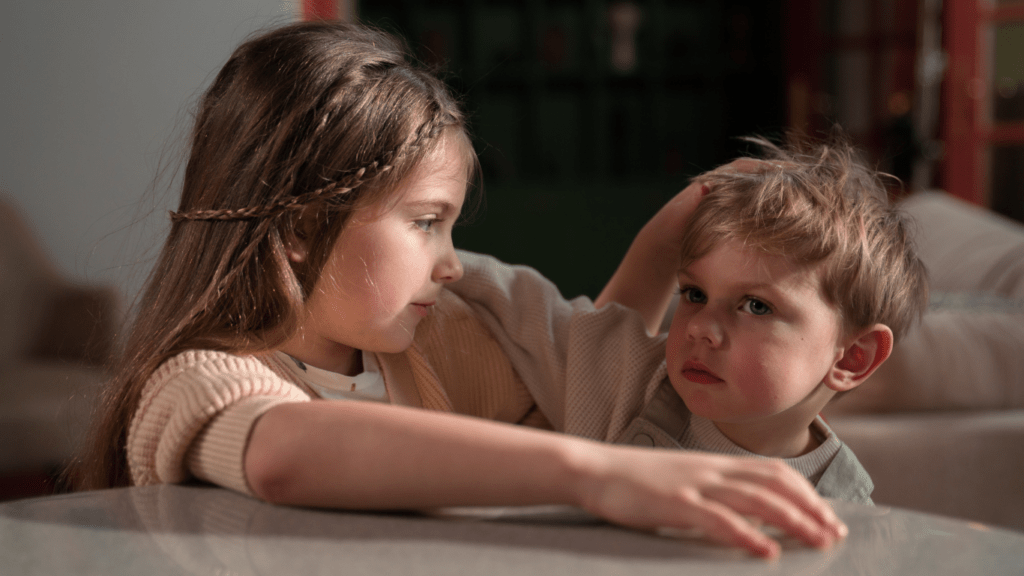Sibling rivalry can feel like a never-ending battle in the home. As a parent, I’ve seen firsthand how conflicts can escalate over the smallest issues, from toy disputes to attention-seeking antics.
It’s natural for siblings to clash, but fostering a peaceful environment is crucial for their emotional growth and family harmony. In this article, I’ll share effective strategies to promote cooperation and understanding among siblings.
By focusing on communication and empathy, we can transform rivalry into a bond that strengthens their relationship. Let’s explore how to create a harmonious home where siblings can thrive together, turning conflicts into opportunities for growth and connection.
Understanding Sibling Rivalry
Sibling rivalry encompasses the ongoing competition and conflict between brothers and sisters. It stems from various factors that affect family dynamics and individual development.
Definition and Common Causes
Sibling rivalry refers to the conflicts, competition, and jealousy siblings can feel towards each other. Common causes include:
- Attention Seeking: Children often compete for parental attention. The desire for validation can lead to conflicts.
- Personality Differences: Distinct personalities can cause misunderstandings and disagreements. Opposing traits amplify rivalry.
- Resource Competition: Sharing toys, privileges, or space creates a sense of scarcity. This competition often ignites conflicts.
- Change in Family Dynamics: New siblings or shifts in family structure can provoke jealousy and insecurity among siblings.
Recognizing these causes helps in addressing underlying issues effectively.
Developmental Stages and Their Impact
Sibling rivalry varies through different developmental stages, including:
- Infancy to Toddlerhood: New siblings might trigger jealousy. Toddlers often respond with attention-seeking behaviors or aggression.
- Early Childhood: Preschoolers, developing social skills, might display frustration and competition as they learn to share and cooperate.
- Middle Childhood: Sibling dynamics usually stabilize, but challenges arise from school-related stress and peer comparisons.
- Adolescence: Teenage years can amplify rivalry due to increased independence and differing interests. Identity formation may lead to distancing.
Recognizing these stages aids in fostering understanding and empathy between siblings.
Effects of Sibling Rivalry
Sibling rivalry can significantly affect a child’s emotional and psychological well-being, influencing their relationships not only with their siblings but also with peers and parents.
Emotional and Psychological Impact
Sibling rivalry often leads to heightened emotions among children. Jealousy and insecurity can manifest, creating feelings of inadequacy. Children may experience anxiety or low self-esteem due to constant comparison.
Over time, these emotional strains can result in behavioral issues, such as aggression or withdrawal. According to a study published in the Journal of Family Psychology, children who frequently engage in rivalry report lower levels of emotional stability, highlighting the need for intervention early on.
Long-term Consequences on Relationships
Long-term consequences of sibling rivalry impact adult relationships. Siblings who experience ongoing conflict may face difficulties in their future interactions, such as building trust with partners and maintaining friendships.
Research from the American Psychological Association indicates that unresolved sibling rivalry can lead to estrangement in adulthood, reducing family cohesion. Establishing harmony in childhood helps prevent these issues, fostering lifelong bonds that support healthy relationship-building skills.
Strategies to Promote Harmony
Promoting harmony among siblings involves practical strategies that encourage cooperation and minimize conflict. I focus on communication, conflict resolution, and nurturing individual interests to create a more peaceful home.
Encouraging Open Communication
Encouraging open communication involves creating an environment where siblings feel safe expressing their feelings. I set aside regular family meetings to allow each child to voice concerns and share experiences. I model active listening by giving full attention when they speak, validating their emotions, and prompting discussions that foster understanding. For instance, asking questions like, “How did that make you feel?” can help siblings articulate their thoughts and resolve misunderstandings.
Implementing Fair Conflict Resolution Techniques
Implementing fair conflict resolution techniques teaches siblings how to handle disputes constructively. I establish clear guidelines for resolving conflicts, such as taking a break to cool down before discussing issues.
I encourage them to use “I” statements, like “I feel upset when…” to express their feelings without blaming each other. I also emphasize collaboration, urging them to brainstorm solutions together that respect both perspectives. This approach not only resolves current disputes but also equips them with essential problem-solving skills for the future.
Fostering Individual Interests and Talents
Fostering individual interests and talents helps reduce rivalry by celebrating each child’s uniqueness. I support siblings in pursuing their hobbies or talents by providing resources and encouragement.
Whether it’s music, sports, or arts, I ensure each child has opportunities to shine independently, reinforcing their self-worth. For example, arranging separate extracurricular activities allows children to explore their interests while minimizing competition. This validation enhances their bond, as they learn to appreciate each other’s strengths rather than viewing them as threats.
Creating a Supportive Home Environment
Creating a supportive home environment fosters positive sibling interactions and promotes harmony. Utilizing family activities and positive parenting techniques lays the foundation for cooperation among siblings.
Setting Up Family Activities
Engaging in family activities strengthens sibling bonds and reduces rivalry. Plan regular family game nights, movie nights, or outdoor excursions to encourage collaboration and teamwork.
Choose activities that align with each child’s interests to ensure everyone feels included and valued. Rotate responsibilities for activity planning, giving each child equal opportunity to lead and express their preferences. Monitor interactions during these activities to guide positive behaviors and reinforce cooperation.
Establishing Positive Parenting Techniques
Utilizing positive parenting techniques creates a nurturing environment conducive to sibling harmony. Consistently model respectful communication, demonstrating how to express feelings and resolve conflicts. Implement praise for cooperative behavior, reinforcing positive interactions among siblings.
Establish clear and consistent rules to set expectations for behavior, allowing children to understand the consequences of their actions. Encourage each child to voice their thoughts during family discussions, promoting an atmosphere of openness and respect.
This approach cultivates empathy and understanding, essential components in transforming sibling rivalry into a supportive family dynamic.


 Maria Chavarria brought a creative heartbeat to Motherhood Tales Pro, helping define its voice and visual identity. Her background in content development and community engagement allowed the platform to resonate deeply with its audience. Maria played a key role in crafting messaging that speaks directly to mothers, amplifying stories and advice that make the brand both relatable and trusted.
Maria Chavarria brought a creative heartbeat to Motherhood Tales Pro, helping define its voice and visual identity. Her background in content development and community engagement allowed the platform to resonate deeply with its audience. Maria played a key role in crafting messaging that speaks directly to mothers, amplifying stories and advice that make the brand both relatable and trusted.